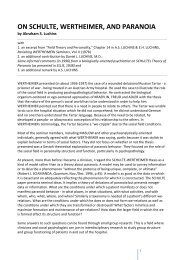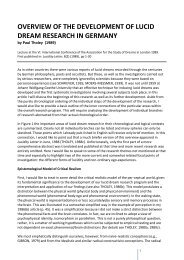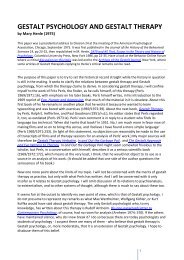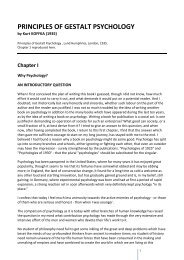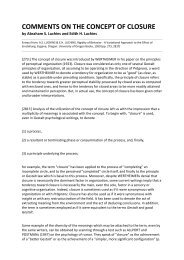232<strong>Gestalt</strong> Theory, Vol. 25 (2003), No. 4However, as expla<strong>in</strong>ed below, I am personally much more <strong>in</strong>cl<strong>in</strong>ed to a purely perceptual-cognitiveapproach say<strong>in</strong>g that movements are functionally controlled solely byway of event files. If this is the case, <strong>Gestalt</strong> factors certa<strong>in</strong>ly play a crucial, canonical,role <strong>in</strong> mak<strong>in</strong>g the body move. <strong>Gestalt</strong> factors might mediate the connection betweenphenomenal content and physical movement.Evidence support<strong>in</strong>g a motoric approach to movement understand<strong>in</strong>g is ambiguousIs there any experimental evidence that the proposed perceptual-cognitive approachto movement control is plausible? Upon review<strong>in</strong>g the literature on human movementcontrol one gets the strong impression, at first sight, that the answer is clearly “no”. It iswidely almost taken <strong>for</strong> granted that a “motoric” approach is adequate. With regard tospontaneous coord<strong>in</strong>ation phenomena, it is often held that there is conv<strong>in</strong>c<strong>in</strong>g or even“overwhelm<strong>in</strong>g” (CARSON et al. 2000) evidence that phenomena such as the symmetrytendency <strong>in</strong> bimanual movements orig<strong>in</strong>ate <strong>in</strong> motoric neuronal structures (e.g.,CATTAERT et al. 1999; HEUER 1993; KELSO 1995; SWINNEN et al. 1997, 1998).On further exam<strong>in</strong>ation, however, it seems fair to say that the experimental results,which are often cited to provide evidence <strong>for</strong> a dom<strong>in</strong>ant role of motoric processes <strong>in</strong>movement coord<strong>in</strong>ation, are virtually always open to a perceptual <strong>in</strong>terpretation aswell. Follow<strong>in</strong>g a thorough review of the literature, I am not aware of any result thatmight not easily be expla<strong>in</strong>ed <strong>in</strong> terms of a purely cognitive and perceptual control ofthe respective movement phenomenon (see MECHSNER 2003; MECHSNER et al.2001). Quite astonish<strong>in</strong>gly, many authors seem to favor a priori a motoric explanation<strong>in</strong> cases where both a motoric and a perceptual explanation are possible. Often they doso without even consider<strong>in</strong>g that a perceptual explanation might be equally conceivable.In one strik<strong>in</strong>g example, it is widely held that the symmetry tendency <strong>in</strong> bimanualmovements reveals a tendency towards co-activation of homologous muscles (e.g.,SWINNEN et al. 1997, 1998). This is done <strong>in</strong> spite of the obvious fact that co-activationof homologous muscles is confounded with spatial, perceptual symmetry of themovement pattern.Regard<strong>in</strong>g motor programs, the reported theoretical and empirical evidence <strong>in</strong> favorof complex motoric representations is not unequivocal. The classical argument <strong>for</strong>the view that complex motor programs are <strong>in</strong>dispensable <strong>in</strong> motor control may be seriouslydoubted. KEELE (1968) refers to so-called ballistic movements, which are per<strong>for</strong>medso quickly that an onl<strong>in</strong>e control via feedback would not be possible. There<strong>for</strong>e,accord<strong>in</strong>g to KEELE, there must be a motoric representation specify<strong>in</strong>g <strong>in</strong> advancethe muscular contraction pattern. However, it is equally plausible to assume that suitable<strong>for</strong>ward and backward mapp<strong>in</strong>gs <strong>in</strong> a cognitive and perceptual functional mediumare fully sufficient to enable humans to per<strong>for</strong>m even ballistic movements. After all,such movements are usually embedded <strong>in</strong> ongo<strong>in</strong>g motor activity which ensures a reasonablyaccurate pre-specification of the relevant movement control parameters us<strong>in</strong>gsensory anticipation, which is a cont<strong>in</strong>uation <strong>in</strong> this case. To cut a long argumentationshort, a purely cognitive and perceptual approach to understand<strong>in</strong>g human movementorganization seems possible, <strong>in</strong> the light of the available evidence.
Mechsner, <strong>Gestalt</strong> <strong>Factors</strong> <strong>in</strong> <strong>Human</strong> <strong>Movement</strong> Coord<strong>in</strong>ation 233A perceptual-cognitive approach to understand<strong>in</strong>g movement is plausibleIs a perceptual-cognitive approach to understand<strong>in</strong>g movement plausible? First,consider the spontaneous symmetry tendency <strong>in</strong> bimanual coord<strong>in</strong>ation. As has beenpo<strong>in</strong>ted out above, the evidence <strong>in</strong> the literature is open to a motoric as well as to aperceptual <strong>in</strong>terpretation. Recent experiments by MECHSNER et al. (2001), however,provide strong evidence suggest<strong>in</strong>g that the symmetry tendency is actually perceptual,and not motoric, <strong>in</strong> nature. In one of their experiments, MECHSNER et al.replicated KELSO’s (1984) classical demonstration of the symmetry tendency <strong>in</strong> thef<strong>in</strong>ger oscillation model as described above. MECHSNER et al. (2001) varied thisparadigm <strong>in</strong> a particular way. Similar to the classical model, participants were <strong>in</strong>structedto periodically move their <strong>in</strong>dex f<strong>in</strong>gers <strong>in</strong> parallel, as well as <strong>in</strong> symmetry.In a trial, a metronome pulse paced the oscillation frequency from 1.4 Hz upto 3.6 Hz, over the course of 24 s. As a newly <strong>in</strong>troduced additional condition, thehands were <strong>in</strong>dividually placed palm-up or palm-down (Figure 2). Positions withboth hands either palm-up or palm-down are called “congruous”. Positions with onehand palm-up and the other palm-down are called “<strong>in</strong>congruous.”FIGURE 2: Instructed palm positions. Congruous positions with both palms down (a) or both palms up(b). Incongruous positions with one palm up and the other palm down (c, d). Repr<strong>in</strong>ted by permissionfrom Nature 414: 69 copyright 2001 Macmillan Publishers Ltd.
- Page 6 and 7: 230Gestalt Theory, Vol. 25 (2003),
- Page 10 and 11: 234Gestalt Theory, Vol. 25 (2003),
- Page 12 and 13: 236Gestalt Theory, Vol. 25 (2003),
- Page 14 and 15: 238Gestalt Theory, Vol. 25 (2003),
- Page 16 and 17: 240Gestalt Theory, Vol. 25 (2003),
- Page 18 and 19: 242Gestalt Theory, Vol. 25 (2003),
- Page 20 and 21: 244Gestalt Theory, Vol. 25 (2003),



